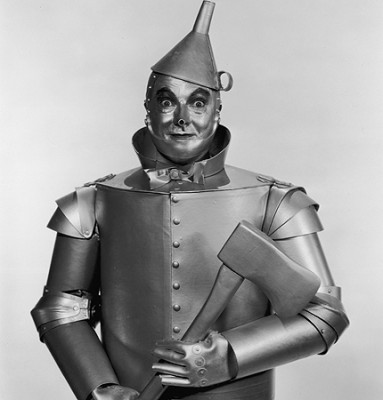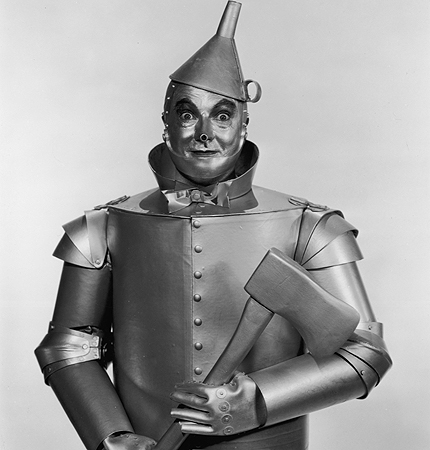What's going on in beauty this week, from head to toe and everything in between.

From Head...
If I only had a heart: Reallllllly hoping the Fifty Shades of Grey makeup line is going to be uber-literal.
...To Toe...
Size me up: People can accurately judge age, gender, income, and attachment anxiety based on shoes alone. And here I thought I had everyone fooled with my sensible beige sandals with contour support and comfort soles, but it turns out they reveal me to be a 36-year-old middle-class lady who falls exactly in the middle of the attachment anxiety spectrum. (Thanks to This Charming Candy for the link. And word up, readers: Such a thing as pistachio-marshmallow lollipops exists in this good world, and This Charming Candy sells 'em.)
Reality bites: Speaking of shoes, how many pairs do you think you own? Now go count them: How many pairs do you actually own? Now go report your numbers to Virginia Postrel, who's conducting an experiment at Deep Glamour. (Me: 12/22. "Oh I hate shopping I'm so spartan I barely own anything and would be happiest in a Zen muumuu la di da.")
...And Everything In Between:
Jury sez: Former Proctor & Gamble executive Rajat Gupta found guilty of insider trading, though one of the two counts in which he was found not guilty was his connection with the personal care company (which, it turns out, also shouldered part of his legal fees). Meanwhile, The Times of India (Gupta was born in India) tells a different story: "Jurors in Tears as They Convict Gupta."
Hit me baby: Bulgarian fashion magazine takes the innuendo of many a fashion photo shoot to its logical extreme and features models made up to look like they've been savagely beaten. The editor says, "Where some see a brutal wound, others see a skilful (sic) work of an artist, or an exquisite face of a beautiful girl." Correct me if I'm wrong, but isn't that the problem?
WHY?: This is only indirectly about beauty, but since I rag on advertising on here it's relevant: Hilariously titled simply "Why?", this site is devoted to asking people who work in the ad world why they do what they do. Jess: "She thinks agencies need the confidence to go after work that’s good for their clients and good for the world. Everyone in advertising wants to sleep at night." Sophia: "When her teachers kept telling her her work was too graphic, she decided to become a graphic designer." It's easy for cynics like me to demonize advertising, but it's rare that we have a chance to just hear people's reasons, plainly stated, for pursuing any career—especially one as uniquely influential as advertising.
Child's play: Sweden considering banning cosmetic surgeons from doing procedures on anyone under 18. Presumably this might also cut down on the chance that a patient under 18 would swallow a scalpel.
Taxed out: Uganda recently approved a 10% tax on cosmetics, and some women are crying foul. The new budget also includes a new maternity hospital—crucial in a country where women are sometimes forced to give birth in hospital hallways for lack of beds—but activist Solome Nakaweesi points out that the gains aren't as great for women as they might seem. "[Men] own most of the construction firms, so they will get money for the roads and bridges. They will not pay graduated tax, school fees or buy food at home. So the man gains. We want our make-up tax-free." She also points out that salons—i.e. woman-owned businesses—may suffer under the tax.
Na zdorov'ya!
Announcement, announcement!: Finally, it has been decided! The world's best-looking women are in Ukraine. This evidence invalidates previous indications that the world's most beautiful women are in Sweden, Venezuela, Russia, Brazil, the United States, Norway, Cyberspace, or Pakistan. It also invalidates earlier findings surrounding the non-Ukrainian Florence Colgate, owner of what was, until this week, thought to be the world's most perfect face; in addition, it may prove potentially libelous for People magazine, which earlier this year proclaimed Beyoncé Knowles, an American R&B singer with no known ties to Ukraine, to be the world's most beautiful person.
Girl's best friend: World's most expensive face cream comes out in September, from Shiseido. Not that it'll make any real difference, unless you're Ukrainian.
V-Day: Thrilled to see that this billboard that basically gave the thumbs-up to street harassment was taken down swiftly, thanks to the decisive efforts of Holly Kearl from Stop Street Harassment. Brava to Ms. Kearl, and also to the marketing director of the mall where the offensive billboard was placed for recognizing the backward message it sent.
Dangerous beauty: In These Times looks at salon workers' rights, specifically with environmental hazards, which are aplenty. The piece also focuses on WE ACT, an organization focusing on the health hazards of personal care products aimed toward ethnic and racial minorities. (And props for their shout-out to writer and friend of The Beheld Virginia Sole-Smith, who has done excellent investigative work on the beauty industry.)
Crisis line: Hugo Schwyzer on how the "man crisis" makes women's perfectionism worse: "As more women and fewer men choose to be successful according to traditional metrics, that shrinking cadre of still-ambitious straight men can afford to be pickier than ever about the women they pursue. Given that many of those men still see women’s beauty as a yardstick with which to measure their own status, it’s not hard to see how the growing problem of male disengagement correlates with the severe (and growing) problems of female hyper-competitiveness, body dysmorphia, and anxiety."
Misinformed: Well-meaning but misguided coroner blames thin models in the tragic death of a 14-year-old girl with bulimia who killed herself after being taunted by classmates for her weight. "The one class of person not here who I feel directly responsible for what happened is the fashion industry. I know this from my own experience, that the problems of eating disorders amongst young people, particularly girls, did not exist before the 1970s," he said. Not only is this inaccurate (there were plenty of eating disorders before the 1970s, albeit in far smaller numbers) but it ignores so much—eating disorder comorbidity with depression, for example, in addition to biological and environmental factors in eating disorders beyond media ideals. The thin imperative is a part of eating disorders, yes. But it's dangerous to simplify an enormously complex disease as being about one thing.
Cat's cradle: Jessica Wakeman puts the Cat Marnell "situation" (she was let go from her position as beauty editor at xoJane.com) kindly, firmly, in perspective.
Backstroke: Twitter trolls have made so many nasty comments about the appearance of British swimmer Rebecca Adlington that the Olympian has had to take a break from the social media site. Michael Phelps has faced much the same abuse—oh wait no he hasn't nevermind.
Geekery 101: I've seen snippets of some not-great news about sexism in geek culture lately, but since I fall more on the dork end of the spectrum than the geek end (and haven't played a video game since Super Mario Brothers), I didn't have proper context. Luckily, Amanda Marcotte, who has a toe in geekdom but not much more, broke it down here: the trouble with objectifying women in geek lore.
I'll be watching you: Zara explains the Color Forecast tool, which digitally analyzes which colors people in fashion-forward cities (Paris, Milan, and...Antwerp) are wearing in real time. As Zara points out, it's nice to see Big Brother being used in a way that isn't individually invasive, but at the end of the day I'm still pretty freaked out by surveillance being driven by the consumer end. Do we really want this? (Also, Zara's blog, Almost Zara, is well worth subscribing to if you're interested in technology and its application to beauty and style. The tagline is "Technology, beauty, and the bizarre," if that's any indication of what you're in for. She leans far more toward digital positivity than I do—despite blogging and tweeting, I tend to be sort of cynical about the lifestyle implications of technology—but that's part of why I like her stuff.)
Heavy metal: 2012 cosmetic packaging trends include metallics, eco-conscious packaging, and "interactivity"—which, I mean, isn't makeup already interactive enough? (Toldja I was a digital skeptic.)
Purr: "The World's First Hello Kitty Beauty Spa Opens in Dubai." Dear lord, there will be more of them?
Homespun: Usually DIY beauty products refers to the mayonnaise-on-hair variety. (Which, by the way, I tried at age 13, and it took dishwashing liquid to get it out of my hair. Why has anyone ever recommended this?) But this high-tech emulsifying kit takes it up a notch, and I'm left wondering if this could be a new craft for lunching ladies. (Certainly at $250 it couldn't be a hobby for the lunchless variety comme moi.)
Fat day: Great piece aimed at the "thin friend" on how to navigate body talk—including when to eschew it altogether—with heavier folks. (via Ashe)
Glow girl: Okay, we all know normally I'm all harrumph about "beauty from the inside out." That said, eating more fruits and vegetables is a good idea in generally, and per No More Dirty Looks it turns out it actually makes you look...tan. (Evidence here.)
Model statement: Actress and Revlon model Emma Stone says she agreed to become a Revlon model to show young girls you don't have to look like a model in order to model. Um.
People of the cloth: Thought-provoking discussion of the role of dress in religion that manages to go beyond modesty (though that's covered as well). Part three is what grabbed me most, with its focus on whether skin was a form of dress, but all three parts are worth reading, and part one features a list of delightful resources like "Quaker Bonnets and the Erotic Feminine in American Popular Culture." (Thanks to Public Historian for the link!)
Photogenic: Shy Biker meditates on distortion and photographs, a subject dear to my heart. As pointed out in the post, there's the kind of distortion where people photograph unrealistically well, and the kind of distortion where people photograph poorly. My two cents: 1) There's also a distortion where you think you look better in photographs when you do something that misrepresents how you actually look (something I finally broke at age 35), and 2) I heard a perfectly logical breakdown once of how it was actually impossible to look better in an untouched photograph than you do in real life, something about how that kind of distortion wasn't a distortion at all but rather a revelation? I don't remember. But I like it!
Control patrol: Two nice posts on bodies and control this week. Sally writes a sort of Serenity Prayer version of body acceptance, about having the strength to accept the things we cannot change and the courage to change the things we can—within the loving boundaries of self-acceptance. Meanwhile, Darlene at Hourglassy reminds us in the context of an inappropriate comment that while we can't control people's reactions to our bodies, we can control how we react to their reaction—and, of course, our attitude toward our own form.
And this week's Girls link is....: Virginia Sole-Smith, on Lena Dunham's body and what it's like to see so much of it: "We’re presented with Lena Dunham’s body, almost entirely without explanation or apology, and then we move on to this smart, funny show that’s about so much more than what her character, Hannah Horvath, looks like." You know, I got so wrapped up in the other questions surrounding the show that by the time I actually saw it, I barely noticed that Hannah's figure isn't Hollywood-standard perfect. And as Virginia's post reminds us, that's exactly how it should be.


